The Collection and Compilation of Historical Data
Executive Order 486, issued by President Elpidio Quirino on December 7, 1951The Collection and Compilation of Historical Data Executive Order 486
The collection and compilation of historical data regarding barrios, towns, cities and provinces was part of post-World War 2 recovery effort of the country. Executive Order 486, (read an official copy as published in Official Gazette Vol. 47 No. 12, dated December 1951) was issued by President Elpidio Quirino on December 7, 1951 containing detailed instructions in the collection, compilation and submission.
This historical data effort was actually the third.
The first was gathered through Executive Order 2 (read an official copy as published in Gaceta Oficial Vol. 9 No. 7, dated February 15, 1911) was issued by Governor-General William Cameron Forbes on January 26, 1911.
The second was gathered through Executive Order 138 (read an official copy as published in Gaceta Oficial Vol. 26 No. 10, dated January 22, 1938) was issued by President Manuel Luis Quezon on January 3, 1938. Note that EO 138 of 1938 was cited in EO 486 of 1951 as EO 136.
A fourth historical data regarding barrios, towns, cities and provinces was gathered through Executive Order 39 (read an official copy as published in Official Gazette Vol. 59 No. 21, dated May 27, 1963) was issued by President Diosdado Macapagal on May 13, 1963.
OFFICIAL GAZETTE
VOL. 47, No. 12
Done in the City of Manila, this 3rd day of December, in the year of Our Lord, nineteen hundred and fifty-one, and of the Independence of the Philippines, the sixth.
By the President:
ELPIDIO QUIRINO
President of the Philippines
MARCIANO ROQUE
Acting Assistant Executive Secretary
MALACAÑAN PALACE MANILA
BY THE PRESIDENT OF THE PHILIPPINES EXECUTIVE ORDER No. 486
PROVIDING FOR THE COLLECTION AND COMPILATION OF HISTORICAL DATA REGARDING BARRIOS, TOWNS, CITIES, AND PROVINCES. WHEREAS, the manuscripts, books and other publications forming the collections of the National Library were almost entirely destroyed during the battle for the liberation of the City of Manila from the Japanese;
WHEREAS, among the documents destroyed were those manuscripts containing important data relating to the history and culture of our barrios, towns, cities, and prov- inces-manuscripts which were collected and preserved by virtue of Executive Orders Nos. 2 and 136, dated January 26, 1911, and January 3, 1938, respectively; and
WHEREAS, it is for our advancement that such data be regathered and brought up to date from time to time, to serve as a source of inspiration and guidance for our future generations, as well as source of materials for historians, investigators and researchers;
Now, THEREFORE, I, Elpidio Quirino, President of the Philippines, by virtue of the powers vested in me by law, do hereby order:
That data on the history and culture of each barrio, town, city, and province be collected and compiled:
That the history of each province be written;
That the Division Superintendent of Schools direct the collection of these data and the preparation of the manu- scripts, using the outline appearing in the Appendix hereto, which is hereby made an integral part of this Order;
That these manuscripts be completed and submitted as soon as possible, but not later than July 4, 1953.
All agencies of the Government as well as private citizens in possession of any pertinent historical data in any form are hereby enjoined to extend their full co- operation to the division superintendents, district super- visors, principals, and teachers entrusted with the execution of this Order.
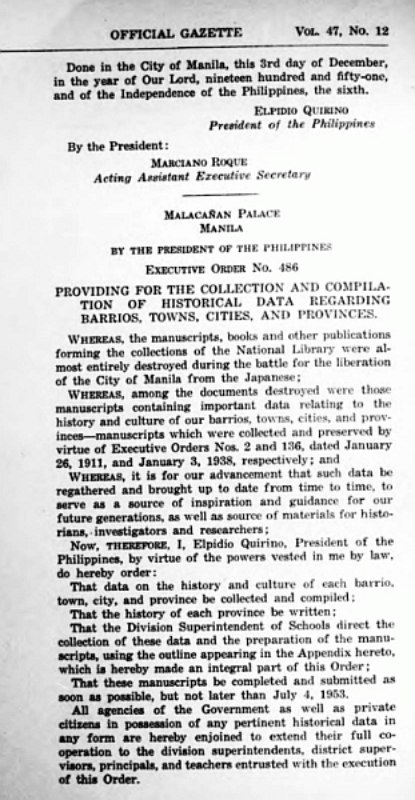
DECEMBER, 1951
OFFICIAL GAZETTE
Done in the City of Manila, this 7th day of December, in the year of Our Lord, nineteen hundred and fifty-one, and of the Independence of the Philippines, the sixth.
By the President:
ELPIDIO QUIRINO – President of the Philippines
MARCIANO ROQUE – Acting Assistant Executive Secretary
APPENDIX
- The Division Superintendent of Public Schools shall immediately issue instructions to each District Supervisor to form in each town or city under his jurisdiction a local committee composed of the Principal of the central elementary school as chairman and at least three teachers as members, preferably those teaching history and social studies.
The function of this local committee shal! be primarily to gather the data on the barrio, town and city, as called for in the outline below. They may call together the wise old men and women of each barrio, sitio or district, who may have a wide knowledge of the life history and culture of the community and obtain the information from them and from the documents or records that they may have in their possession. The records of the municipal or city government and those of the church may, and in some cases must, be consulted. No possible sources of data be overlooked.
In case any community has in its possession a copy of the manu- script called for by Executive Order No. 2 of January 26, 1911 or No. 136 of January 3, 1938, the local committee may simply add to the materials contained therein the additional data called for in the accompanying outline.
The data gathered should be so compiled and arranged as to constitute convenient source materials for the use of those who may wish to write the history of the community.
The local committee is not expected to write the history of the community. However, if it attempts to do so, the result of its labor will constitute one step forward in the intellectual advancement of the community.
In the preparation of the manuscript, the names of the persons or families that have kept the documents consulted by the committee should be cited as a form of recognition for their help and for having preserved these valuable records.
The manuscript shall be signed by the members of the local committee and must have a foreword of the district supervisor; while the records taken of the data mentioned in Nos. 10 to 26 and Nos. 27 to 33 of the outline, must be authenticated with the signature of the persons who furnish the information.
- The Division Superintendent shall also form a provincia: committee, composed of the Principal of the high school as chairman and at least four high school teachers of history, social studies or English as members. This committee shall write the history of the province. Inasmuch as several items in the following outline call for materials that may be touched in part or in full by the local committees in charge of the collection of data on the different barrios, towns or cities in the province, it would be well for the provincial committee to keep in close consultation with said local committees.
The history of the province shall be signed by the provincial committee and shall be submitted with a foreword of the Division Superintendent. Any reference to the work of the local committees should be duly acknowledged.
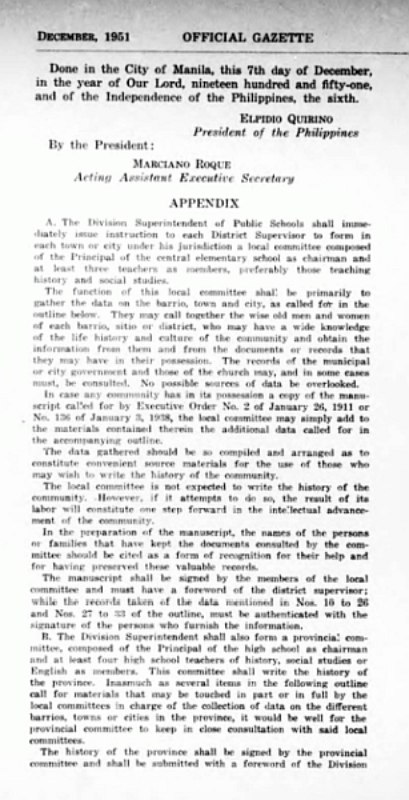
C
The manuscripts shall be prepared on legal-sized paper of durable quality and must have a left margin of not less than one and five-eighth inches to allow enough space for binding. The original and one carbon copy shall be forwarded to the Director of Public Libraries, through the Division Superintendent.
- The data desired shall, as much as possible, be roughly arranged in accordance with the following outline:
- HISTORY AND CULTURAL LIFE OF THE BARRIO
Part One: History
- Present official name of the barrio.
- Popular name of the barrio, present and past; derivation and meanings of these names. Names of sitios included within. the territorial jurisdiction of the barrio.
- Date of establishment.
- Original families.
- List of tenientes from the earliest time to date.
- Story of old barrios or sitios within the jurisdiction that are now depopulated or extinct.
- Data on historical sites, structures, buildings, old ruins, etc.
- Important facts, incidents or events that took place.
(a) During the Spanish occupation.
(b) During the American occupation to World War II.
(c) During and after World War II.
(Mention dates, places, personalities, etc. Political, educational, economic, religious and other events and developments are to be recorded under this head.)
- (a) Destruction of lives, properties and institutions during wars, especially in 1896-1900 and 1941-1945.
(b) Measures and accomplishments toward rehabilitation and reconstruction following World War II.
Part Two: Folkways
- Traditions, customs and practices in domestic and social life: birth, baptism, courtship, marriage, death, burial: visits; festivals; punishments; etc.
- Myths, legends, beliefs, interpretations, superstitions: origin of of the world, land, mountains and caves, seas, lakes, rivers; plants, trees, animals; sun, moon, stars, eclipses, earthquakes, lightning and thunder, clouds, rain, wind, storms, changes of climates; other natural phenomena; first man and woman; birth of twins or more; sickness; witchcraft, magie; divina- tion; etc.
- Popular songs; games and amusements.
- Puzzles and riddles.
- Proverbs and sayings.
- Methods of measuring time, special calendars. 16. Other folktales.
(Materials on these topics may preferably be written in the local language and should be accompanied with English translation, either literary or free, whichever is more effective in conveying the idea embodied therein.)
Part Three: Other Information
- Information on books and documents treating of the Philippines and the names of their owners.
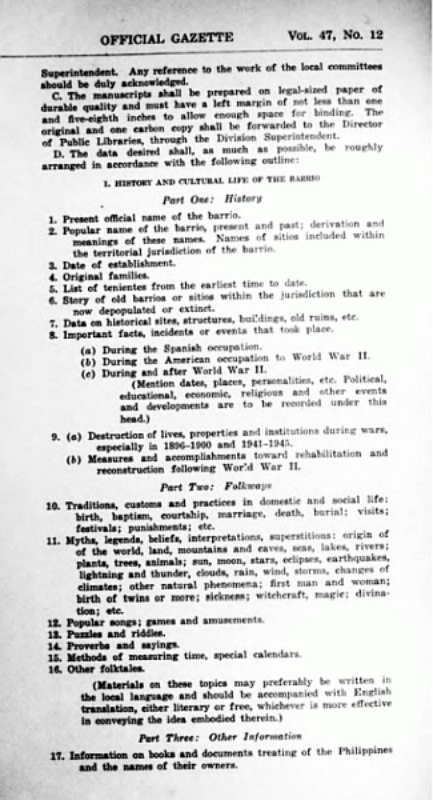
18. The names of Filipino authors born or residing in the community, the titles and subjects of their works, whether printed or in manuscript form, and the names of persons possessing these.
-
HISTORY AND CULTURAL LIFE OF THE TOWN OR CITY
Part One: History
- Present official name of the town or city.
- Former name or names and their meaning or derivation.
- Date of establishment.
- Names and social status of the founders.
- Names of persons who held leading official positions in the community, with the dates of their tenure, if possible.
(In the Spanish time, the leading officials were: goberna- doreillo, capitan municipal, teniente absoluto, eura parroco, jueces de sementera y de policia, maestro municipal. In the American time: president and vice president, mayor and vice- mayor, justice of the peace, councilors. municipal treasurer, municipal secretary, chief of police.)
- Data on historical sites, structures, buildings, old ruins, etc.
- Important facts, incidents or events that took place: (a) During the Spanish occupation.
(6) During the American occupation to World War II. (e) During and after World War II.
(Mention dates, places, personalities, etc. Political, educational, economic, religious and other events and developments are to be recorded under this head.)
- (a) Destruction of lives, properties and institutions during wars, especially in 1896-1900 and 1941-1945.
(b) Measures and accomplishments toward rehabilitation and reconstruction following World War II.
Part Two: Folkways
- Traditions, customs and practices in domestic and social life: birth, baptism, courtship, marriage, death, burial; visits; festivals; punishments; etc.
- Myths, legends, beliefs, interpretations, superstitions: origin of the world, land, mountains and caves, seas, lakes, rivers; plants, trees, animals; sun, moon, stars, eclipses, earthquakes, lightning and thunder, clouds, rain, wind, storms, changes of climates; other natural phenomena; first man and woman; birth of twins or more; sickness; witchcraft, magic; divina- tion; etc.
- Popular songs; games and amusements.
- Puzzles and riddles.
- Proverbs and sayings.
- Methods of measuring time, special calendars.
- Other folktales.
(Materials on these topics may preferably be written in the local language and should be accompanied with English translation, either literary or free, whichever is more effective in conveying the idea embodied therein.)
Part Three: Information
- Information on books and documents treating of the Philippines and the names of their owners.
- The names of Filipino authors born or residing in the com-
munity, the titles and subjects of their works, whether printed or in manuscript form, and the names of the persons possessing them.
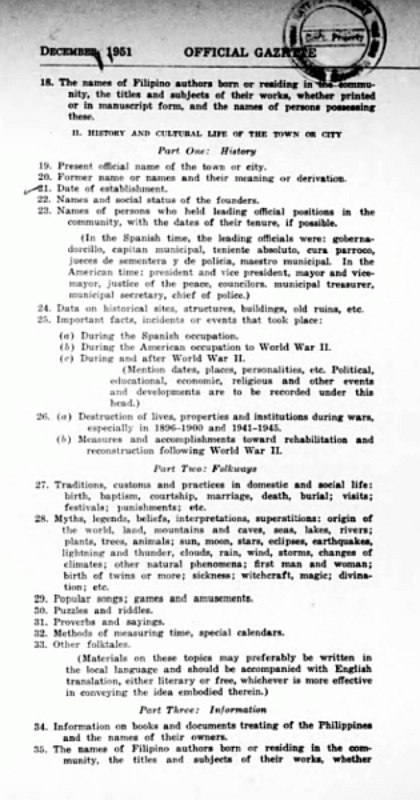
III. HISTORY OF THE PROVINCE
- Present official name of the province.
- Former name or names, their derivation and meaning.
- Date of establishment; changes of boundaries.
- Chronological list of the alcaldes mayores, governors and other principal officials, indicating their tenure of service.
- Names of some of the most outstanding citizens (only those dead to be included) and their achievements.
- Important facts, incidents, events or developments that took place.
(a) During the Spanish occupation.
(b) During the American occupation to World War II.
(c) During and after World War II.
(Mention dates, places, personalities, etc. Political, educational, economic, religious and other events are to be recorded under this head.)
- (a) Destruction of lives, properties and institutions during wars, especially in 1896-1900 and 1941-1945.
(b) Measures and accomplishments toward rehabilitation and reconstruction following World War II.
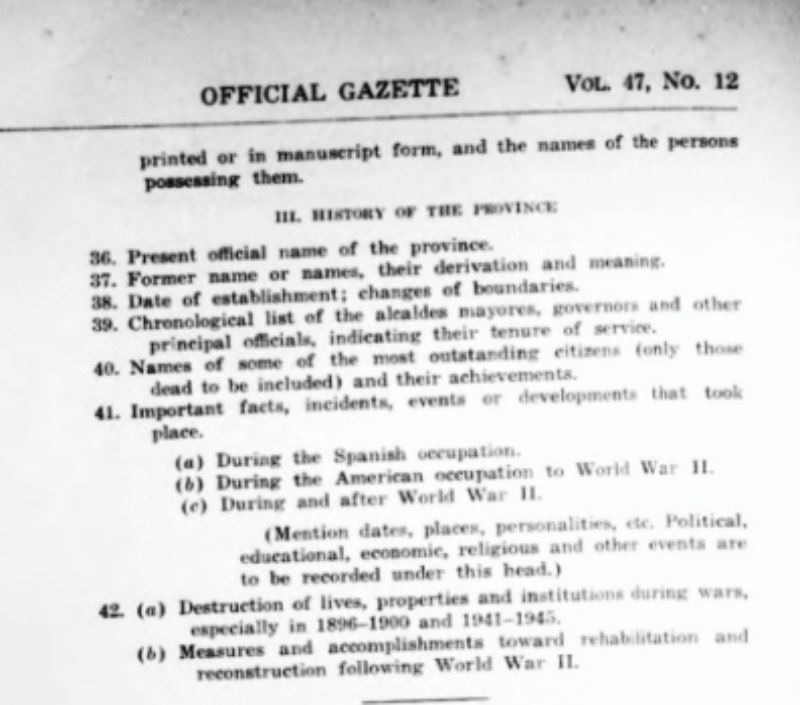
The information is the product of community surveys and interviews made by competent resource persons and research jointly undertaken by teachers, principals, supervising principals, and division supervisors, municipal and provincial officials, and prominent citizens who had the intimate knowledge and understanding of the local materials and resources.
The original notes can be found on the NLP website ( https://nlpdl.nlp.gov.ph/HD01/home.htm ) and are in the Public Domain.
***Original photo copies transcribed by Abramazing.com
Did you like “The Collection and Compilation of Historical Data EO 1953″ ? If so then please share this page with your friends.
Leave a comment below to let me know what you liked best.
Follow ABRAmazing on Facebook, Instagram ,Twitter and Pinterest for more travel adventures and be notified about my latest posts and updates!
Thankyou for sharing 🙂
Please Note – All blog post photos on Abramazing.com are of a lower quality to enable faster loading and save you data. If you would like to buy or license higher quality copies of any of the photographs you can email us at abramazing.ph@gmail.com
All photographs and content on this website remain the property of Abramazing.com. Images may not be downloaded, copied, reproduced or used in any way without prior written consent.
Print purchases entitle the purchaser to the ownership of the image but not to the copyrights of the image which still remain with Abramazing.com even after purchase.

Follow Abramazing for more Culture, Heritage, Food and Travel around Abra
Facebook @Abramazing.Ph | Instagram @Abramazing.Ph
Twitter @Abramazing | Pinterest @AbramazingPh
Affiliate Disclaimer: Links on this website may be affiliate links that could result in us receiving compensation when you purchase a product or service from that link. You do not pay any extra fees for these items. This helps us to keep this website going. Thank you for your support.
Disclaimer | Privacy Policy | All Rights Reserved



